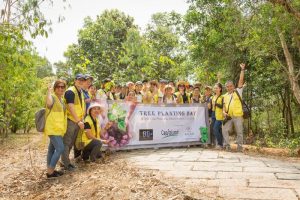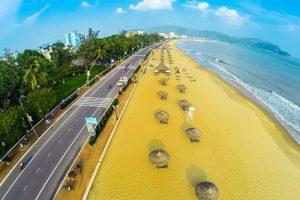Phu Quoc island district targets over 1.8 million tourists in 2017
Phu Quoc island district in the southern province of Kien Giang strives to lure over 1.8 million tourists, including 300,000 foreigners, in 2017, showing a year-on-year increase of 25.5% and 42.7%, respectively.
The tourism sector aims to fetch more than VND11.15 trillion (US$499 million) in revenue this year, up 25% against 2016.
Vice Chairman of the district’s People’s Committee Huynh Quang Hung said to realise the aforesaid goals, the district will push ahead with trade and tourism promotion activities, as well as tighten management in the field, and preserve historical relic sites on the island.
The sector will host more traditional festivals, build new tourism products, and improve quality of maritime services.
Apart from stepping up domestic and international coordination, the district moves to launch new tours to diversify tourism products, including the opening of Da Lat-Phu Quoc air route and international ones to the pearl island.
Authorities will also work to raise public awareness of environmental protection.
Phu Quoc now attracts around 220 investment projects in tourism worth over VND222 trillion (US$11.1 billion), making up 79% of the provincial total investment projects.
The district granted investment licenses to 167 projects worth VND126.6 trillion (US$6.33 billion) with 30 ones capitalised at VND31 trillion being put into operation.
Phu Quoc strives to become a hi-end tourism resort in the region and beyond by 2020.
During the National Tourism Year 2016, Phu Quoc welcomes over 1.45 million tourists, surpassing the yearly target of 20.8%, and registering a year-on-year increase of nearly 63%. The total revenue from tourism was estimated at over VND8.9 trillion, up 32.4% against 2015.
Danang tourism promoted in Hanoi
The Danang Department of Tourism held an event in Hanoi on January 4 to promote upcoming events scheduled to take place in the central city throughout this year.
Deputy director of the city’s Tourism Department Truong Thi Hong Hanh said the annual international firework festival this year in Danang will last for two months from April 24 to June 24, instead of 2 days as in previous years.
The festival is expected to gather firework artists from Switzerland, China, Australia, Austria, Japan, the UK and Italy, among others.
The city will also host the sixth Asian Golf Tourism Convention from May 7 to 13. This is the annual event held by the International Association of Golf Tour Operators (IAGTO) and the biggest of its kind in Asia, which includes an award ceremony honouring countries and regions with outstanding golf achievements.
To serve the expected influx of visitors, an under-construction international terminal at Danang airport is planned to become operational in March 2017 with a yearly capacity of between four and six million passengers.
Danang currently has 575 accommodation facilities, offering up to 22,000 rooms. The central tourism hub is piloting a mobile phone software application, Danang FantastiCity, to help visitors plan tours and find tourist information in Vietnamese and English.
Vietnamese jailed for promising fake jobs in Taiwan, Netherlands
She cheated 100 jobseekers from the impoverished central region out of more than US$80,000.
A court in the central province of Nghe An sentenced a woman to 12 years in jail on January 3 for swindling over 100 poor job-seekers into paying her US$82,700 for non-existent work in Taiwan and the Netherlands.
Hoang Thi Dao, 52, started the scheme after she spent four years working in Taiwan, according to the indictment.
In June 2012, she began telling prospective migrants about vacancies at a food company in Taipei and asked interested candidates to pay her VND5 million (US$220) for training and health examinations.
She also advertised more than 50 vacancies at a dairy farm in the Netherlands, promising wages of at least US$1,000 a month. Those who wanted the job had to pay her US$500 — a “labor export fee.” Vietnam’s average annual income was around US$2,200 last year, according to the General Statistics Office.
Although Dao lacked a labor export license, nearly 100 people in Nghe An and neighboring Ha Tinh Province trusted her sales pitch and the small receipts she gave each of them.
She also took all the candidates to Hanoi for health examinations, before asking each person for another US$1,300 to cover airline tickets and visa fees.
The victims contacted police after waiting for their flights for months. By the time investigators caught up to her, Dao had sold her house, left the province and could not be reached by phone.
Police arrested Dao in early 2015 in the Central Highlands and ordered her to return VND1.88 billion (US$82,700) to her victims.
Vietnamese official labor exporters sent 98,410 workers overseas in the first ten months of 2016, according to reports from the companies. But there are also a large number of those working abroad illegally.
Many of the overseas workers are from the impoverished central region where harsh weather conditions tolerate few business options.
Official government reports show at least a million still live in hunger and roughly 10% of the population remains below the poverty line, an average annual income of less than US$374.
Can Tho strives for all communes as new rural areas by 2020
Can Tho will strive to have all its 36 communes qualified as new rural areas by 2020, Hoang Kim Cuong, head of the city’s Coordination Office for Building New Rural Areas, said.
At a conference on January 4 reviewing the national goal programme on building new rural areas in 2016 in Can Tho and implementing tasks in 2017, Cuong said to achieve the goal, 24 communes should fulfill the criteria for new rural areas during 2016 and 2020.
Besides local efforts, Can Tho has proposed the central government provide part of investment to build infrastructure in rural areas and assist with removing policy obstacles in carrying out the new rural area building programme.
During the 2011-2015 period, the city had 12 communes recognised as new rural areas and eight more earned the recognition in 2016.
The national programme on building new-style rural areas, initiated by the Government in 2010, includes 19 criteria on socio-economic development, politics and defence, aiming to boost rural areas of Vietnam.
The criteria cover infrastructure development, production capacity improvement, environmental protection and cultural value promotion.
HCM City to better care for the needy
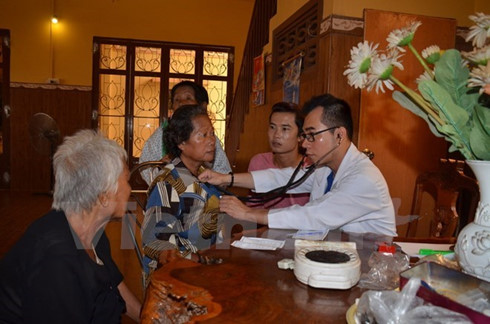
Ho Chi Minh City will continue exerting efforts to improve living conditions for poor households and disadvantaged groups needing support, affirmed Nguyen Thi Thu, Vice Chairwoman of the municipal People’s Committee.
At a conference held by the city’s Department of Labour, Invalids and Social Affairs on January 4, she asked the department to focus on reviewing the list of welfare policy beneficiaries and revolution contributors, ensuring all of them receive adequate support.
In the upcoming Lunar New Year (Tet) festival, the department should coordinate with other departments and agencies to care for the needy, she said, revealing that the city People’s Committee has decided to increase budget allocation for Tet gifts to policy beneficiaries, revolution contributors and the poor by 15 percent, or 100 billion VND, from last year.
Thu also requested the department to keep updated on the wage and Tet bonus that local enterprises pay labourers, while working with the firm to ask them to care for labourers in the most important event of the year.
In 2017, the department is assigned to devise measures to boost the labour market and create more jobs for labourers, while diversifying job placement services.-
Dak Lak fulfils universal preschool education for five-year-old kids
The Central Highlands province of Dak Lak has fulfilled universal preschool education for five-year-old children, Director of the provincial Department of Education and Training Pham Dang Khoa said on January 4.
From 2010 – 2015, the province has poured over 2.37 trillion VND (104.54 million USD) into building infrastructure facilities, purchasing equipment, and enhancing teaching and managing staff capability.
There are 293 kindergartens with 3,042 classrooms in the province. All of the facilities are equipped with computers for teaching and caring activities.
The province has 7,866 preschool teachers and managers, up 2,977 from the previous five-year period.
In the reviewed period, nearly 21,000 children under five joined preschool education. All local five-year-old children participated in day-boarding schools. The quality of caring and educational services has been enhanced, thus lowering the child malnutrition rate below 7 percent.
According to Khoa, in the next five years, the province will continue building on the positive outcomes, further investing in infrastructure facilities and teaching and managing staff capability.
Communication work will be also promoted to raise public awareness of preschool education.
The rate of child malnutrition is expected to fall below 5 percent while raising the rate of day-boarding preschool children by 1 – 2 percent per year.
Enterprises help the poor enjoy Lunar New Year
As many as 178 firms have donated more than 32 billion VND (1.4 million USD) to help disadvantaged residents in the central province of Nghe An enjoy the upcoming Lunar New Year (Tet) holiday.
The donation was raised at an event held in Vinh city on January 4, during which local enterprises were honoured by the provincial authorities for their contributions.
About 16,000 companies are operating in Nghe An. They have so far donated nearly 70 billion VND (3.08 million USD) for social security activities in the province.
Meanwhile, in the Central Highlands province of Kon Tum, 22 charity houses were handed over to poor families in Dak Ha district and Kon Tum city on January 3 and 4.
Construction of each house cost 50 million VND (2,200 USD), sourced from the VinGroup’s Thien Tam fund.
Also on January 4, the Department of Labour, Invalid and Social Affairs and the fund for children of Long An presented 100 gifts worth 100 million VND (4,400 USD) for needy students in the Mekong Delta province.
The gifts were sponsored by businesses.
Farmers’ Union promotes support for farmers
The Central Committee of the Vietnam Farmers’ Union (the sixth tenure) held its 10th meeting in Hanoi on January 4 to review the 2016 implementation and set out tasks for 2017.
President of the union Lai Xuan Mon said in 2016, numerous natural disasters hit the nation, causing losses amounting to 1.7 billion USD to the agriculture sector, or nearly one percent of the national GDP.
The Government for the first time called for assistance from international organisations and mobilized 26.4 million USD from all sources for affected localities, Mon said.
Thanks to the timely support, the agriculture sector was still able to post a growth rate of 1.36 percent and an increase of 1.44 percent in production value, earned 32.1 billion USD from agro-forestry and fishery exports, an increase of 5.4 percent from 2015.
The Farmers’ Union has launched a wide range of programmes to help farmers to improve their production and living condition.
The Supporting Fund for Farmers mobilised over 311 trillion VND (13.68 billion USD), offering preferential loans for over 6,800 farming households. Nearly 500 cooperative production models have been developed, contributing to strengthening connection among farmers in production and products consumption.
The union’s chapters at all levels organised training workshops and transferred technology on cultivation, animal husbandry, aquaculture, small-industry and handicraft for over 2.9 million members. They also set up 9,350 piloted production models in accordance with the national Good Agricultural Practice (VietGAP) standard.
Participants focused their discussion on shortcomings and challenges facing the union with a view to reforming the union’s operation.
They stressed the building of linkages among farmers and between farmers and enterprises along with the restructuring of agricultural production in the direction of creating value chains.
In 2017, the association will coordinate with relevant agencies to enhance farmers’ understanding of international integration to ensure the key role of agriculture and rural areas in the nation’s economic development.
Tien Giang to expand large-scale fields
The Mekong Delta province of Tien Giang aims to build more large-scale rice fields towards a total acreage of 11,070ha, 3,500ha more than last year, a local official has said.
Acting Director of the provincial Department of Agriculture and Rural Development Cao Van Hoa said the programme is expected to draw the participation of nearly 15,000 households in 41 communes in nine districts.
To fulfil the target, the province will work to raise public awareness and devise policies to encourage the development of large-scale fields. Advanced technology will also be applied, along with mechanisation and environment protection activities, to mitigate pollution in agriculture.
Tien Giang province has had 20 large-scale fields in western districts and five in eastern districts in 2016, with the largest field covering 500ha in Cai Be district.
Large-scale fields have connected farmers in large-scale production using scientific and technological advances, thus reducing production cost while significantly boosting the quality of produced products.
Farmers’ Union promotes support for farmers
The Central Committee of the Vietnam Farmers’ Union (the sixth tenure) held its 10th meeting in Hanoi on January 4 to review the 2016 implementation and set out tasks for 2017.
President of the union Lai Xuan Mon said in 2016, numerous natural disasters hit the nation, causing losses amounting to 1.7 billion USD to the agriculture sector, or nearly one percent of the national GDP.
The Government for the first time called for assistance from international organisations and mobilized 26.4 million USD from all sources for affected localities, Mon said.
Thanks to the timely support, the agriculture sector was still able to post a growth rate of 1.36 percent and an increase of 1.44 percent in production value, earned 32.1 billion USD from agro-forestry and fishery exports, an increase of 5.4 percent from 2015.
The Farmers’ Union has launched a wide range of programmes to help farmers to improve their production and living condition.
The Supporting Fund for Farmers mobilised over 311 trillion VND (13.68 billion USD), offering preferential loans for over 6,800 farming households. Nearly 500 cooperative production models have been developed, contributing to strengthening connection among farmers in production and products consumption.
The union’s chapters at all levels organised training workshops and transferred technology on cultivation, animal husbandry, aquaculture, small-industry and handicraft for over 2.9 million members. They also set up 9,350 piloted production models in accordance with the national Good Agricultural Practice (VietGAP) standard.
Participants focused their discussion on shortcomings and challenges facing the union with a view to reforming the union’s operation.
They stressed the building of linkages among farmers and between farmers and enterprises along with the restructuring of agricultural production in the direction of creating value chains.
In 2017, the association will coordinate with relevant agencies to enhance farmers’ understanding of international integration to ensure the key role of agriculture and rural areas in the nation’s economic development.
Tien Giang to expand large-scale fields
The Mekong Delta province of Tien Giang aims to build more large-scale rice fields towards a total acreage of 11,070ha, 3,500ha more than last year, a local official has said.
Acting Director of the provincial Department of Agriculture and Rural Development Cao Van Hoa said the programme is expected to draw the participation of nearly 15,000 households in 41 communes in nine districts.
To fulfil the target, the province will work to raise public awareness and devise policies to encourage the development of large-scale fields. Advanced technology will also be applied, along with mechanisation and environment protection activities, to mitigate pollution in agriculture.
Tien Giang province has had 20 large-scale fields in western districts and five in eastern districts in 2016, with the largest field covering 500ha in Cai Be district.
Large-scale fields have connected farmers in large-scale production using scientific and technological advances, thus reducing production cost while significantly boosting the quality of produced products.
Military hospital joins cooperation activities with Singapore doctors
Military Hospital 175, based in Ho Chi Minh City, and the Singapore General Hospital are carrying out joint activities as part of their cooperation programme.
During its four-day stay in Vietnam, the Singaporean delegation, led by Prof. Tay Boon Keng, will give training to doctors of Military Hospital 175, which is under the Vietnamese Defence Ministry.
They will also offer free check-ups and surgeries for disadvantaged patients and organise a symposium, according to the Quan doi Nhan dan (People’s Army) daily.
On the first working day (January 4), the two sides agreed on several cooperation activities in 2017 such as training caregivers and transferring surgical and orthopaedic techniques to the Vietnamese hospital.
More medical experts from Singapore will be sent to Military Hospital 175 in the future to provide training, exchange experience and give examination and treatment.
12 Vietnamese provinces request urgent rice support before Tet
Twelve provinces across Vietnam have requested emergency rice supply from the central government in order to assist disaster-struck residents ahead of the Lunar New Year.
According to Le Viet Phai, an official from the Department of Social Support under the Ministry of Labor, War Invalids and Social Affairs, the agency had received documents from 12 provinces as of January 3, asking for a total of 14,700 metric tons of rice to assist local residents.
The provinces include Cao Bang, Tuyen Quang, Yen Bai, Lao Cai, and Ha Nam in northern Vietnam; Thanh Hoa, Nghe An, and Quang Tri in the north-central region; Quang Ngai, Binh Dinh, and Ninh Thuan in south-central Vietnam; and Dak Nong in the Central Highlands.
This kind of request for assistance before the Lunar New Year is not unprecedented, Phai said, explaining that about 19 provinces sought similar support during the same period last year.
More requests are expected to be submitted as many provinces in the country, especially those in the central region and the Central Highlands, continue to feel the impact by prolonged downpours and flooding over the past year, devastating the lives of local citizens and the production of local paddies.
The Ministry of Labor, War Invalids and Social Affairs issued a notice in November, asking authorities to review the local situation to determine the number of residents in need of support before making their requests.
The rice will be provided to the provinces until January 20 as the Lunar New Year is due on January 28.
Vietnam’s labor union bristles at plan to double overtime limit
Bringing the cap to 600 hours a year will allow employers to exhaust their workers and cut back hiring, it says.
The Vietnam General Confederation of Labor, which represents unions across the country, has spoken out against a proposal to raise the cap on overtime, arguing that such a move will lead to many workers becoming exhausted.
Under a proposed Labor Code amendment, the Ministry of Labor, Invalids and Social Affairs wanted to double the overtime limit that an employee may work to a maximum of 600 extra hours per year.
Another option is to scrap the annual overtime limit, but restrict employees to a daily cap of 12 hours.
The labor confederation has opposed both these options.
Le Dinh Quang, deputy director of the Department of Labor Relations under the state-run labor organization, said employers could take advantage of the new policy and ask their staff to work longer hours instead of adding new jobs.
Quang said although the current overtime limit in Vietnam is not high, the average worker still clocks in 48 hours per week, or more than 2,400 hours per year.
If the overtime limit is raised, the total number of working hours will become too high, he said.
According to Quang, the overtime limit for an employee in the Republic of Korea is 624 hours per year but the total working hours there must not surpass 2,446 hours in a year.
The federation said the limit should only be increased to 400 hours.
Vietnam’s Labor Code stipulates that an employee can work a maximum of 200 extra hours per year. In some specific industries like textiles and garments, leather, aquaculture processing, telecommunications, water and power supplies, overtime is capped at 300 hours per year.
Prime Minister Nguyen Xuan Phuc in early December asked relevant ministries and agencies to consider adjusting the overtime limit following recommendations from foreign firms.
The overtime limit is 1,800 hours in Thailand, 1,250 in Malaysia, 860 in Singapore and 540 in Laos.
A recent survey conducted by national broadcaster VTV at Hanoi’s Thang Long Industrial Zone revealed that 97% of the workers there wanted to work overtime as the money from extra hours accounted for a third of their monthly income.
Golf tourney connects overseas Vietnamese
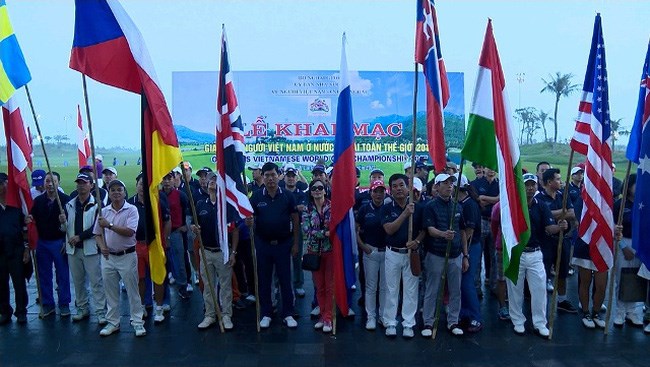
The Overseas Vietnamese World Golf Championship 2017 kicked off in Thanh Hoa province on January 4, attracting 160 expatriates from 20 countries and territories.
At the opening ceremony, Deputy Foreign Minister Vu Hong Nam, who is also Chairman of the State Commission on Overseas Vietnamese Affairs, said he hopes the tourney, the second of its kind, will give participants a chance to not only share their passion of the sport but also find friends and partners.
Chairman of the overseas Vietnamese golf association Tran Tri Tue also hoped that through this event, expatriate golfers will join together in many activities for the sake of their homeland.
Businessman Hoang Hieu Huy said his Australian team comprises 30 players and they take part in the hope of connecting with counterparts in business and investment activities in Vietnam.
Truong Van Chinh, a businessman from Germany, said he also wants to seek new friends at this event to exchange business experience and work to benefit the homeland.
The golf championship is organised by the State Commission on Overseas Vietnamese and the Overseas Vietnamese Golf Association.
Làn Sóng Xanh rewards some of VN’s top stars
Composer Khắc Hưng and his song Sau Tất Cả (After All) were honoured at the 19th Làn Sóng Xanh (Green Wave) Music Awards in HCM City on Tuesday.
The annual awards, launched in 1997 by the Radio Voice of HCM City, are organised to honour composers, singers and bands who have made outstanding contributions to Vietnamese music during the year.
The awards ceremony gathered famous young Vietnamese musicians and singers such as Lê Thiện Hiếu, Suni Hạ Linh, Only C, Lou Hoàng, Rocker Nguyễn, Hòa Minzy and Minh Như to perform their latest hits.
The song Sau Tất Cả performed by singer Erik was named Phenomenon Song of the Year.
In the Top Gold – Most Favourite Singer categories, the winners included Đàm Vĩnh Hưng, Hồ Quỳnh Hương, Hà Anh Tuấn, Hồ Ngọc Hà and Tuấn Hưng. Meanwhile, Top Hits of the Year went to Đông Nhi, Noo Phước Thịnh, Sơn Tùng M-TP, Tóc Tiên and Isaac.
In the category Best Single of the Year, singer Noo Phước Thịnh, composer Đỗ Hiếu and choreographer Trung Hiếu became the winner with the song Because I Love You.
Soobin Hoàng Sơn and Bảo Anh received Promising Male and Female Singer awards, respectively.
Lê Công Đồng, Director of the Radio Voice of HCM City, said next year, the award format will be changed a little to upgrade quality and attract the public’s attention.
“The 20th Làn Sóng Xanh Music Awards will have some new categories to honour modern Vietnamese music,” he said.
One more dengue death reported in HCMC in early 2017
The Ho Chi Minh City Department of Preventive Medicine yesterday said that one more death of dengue fever is recorded.
A 35 year old woman in Thu Duc District died before she was rushed to the district General Hospital as she had dengue and serious pneumonia. Her death has brought total deaths in the city to six since 2016.
Head of the Department’s Infection Disease Control Ward Dr. Le Hong Nga said that statistically, there have been 21,367 dengue cases in the city in 2016 equal to 2015.
Last year, the disease peak fell in October and November. It is dropping now yet in some districts such as Thu Duc, 5, 3, 10, serious cases have soared.
In an epidemiology survey, for years, mosquito larva –factor to cause dengue- lives not only in water containers in families but also in other devices.
HCMC businesses will need 40,000 new workers after Tet: report
The Ho Chi Minh City’s Center for Forecasting Manpower Needs and Labor Market Information (FALMI) said that Ho Chi Minh City businesses will need 40,000 new employees or 3 percent in January and February after Tet holidays (the Lunar New Year).
The rate of workers moving between companies is just 15 percent, the labor center said.
The rate of jumping workers and shortage of employees after the Lunar New Year is low because employees want to have stable job and most of enterprises have good bonus policy to keep their workers stay.
In addition, demands of sale person, marketing, food processing, house helping, security, ornamental plant takers, tour guides and delivery services is predicted to increase in January and February by 40,000 jobs.
The center said that the city will recruit skilled employees for textile and garment, leather shoes making, food processing, construction in March.
In 2017, the city is expected to create 140,000 new vacancies, an increase of 7.7 percent compared to 2016.
Happy Feet running race to kick off
A running event titled “Happy Feet: The Energetic Running Race” is scheduled to kick off on Sunday in Quang Trung Software Park in HCM City’s District 12.
The race will attract 800 runners aiming to use a professional race to promote running in the community.
Participants will take part in two categories: 5km and 10km. All the finishers will get a medal and a T-shirt.
The event is organised by VietRunners club and Hoa Sen University.
Đại Từ tea festival kicks off
The Đại Từ Tea Festival 2016 featuring a tea tasting night, music performance and the “Golden hand making tea” competition was held on Tuesday in Đại Từ District in the northern Thái Nguyên Province.
The annual festival is being held to promote tea products and Đại Từ tea to customers and to systematically create the Đại Từ tea brand. It is also an opportunity for businesses in the locality to connect and exchange producing, processing and consuming experiences, according to Vice Chairman of Đại Từ’s People’s Committee, Lê Thanh Sơn.
There were nearly 200 booths at the festival, with tea products and other products of the craft villages that locals had prepared for the Lunar New Year on display.
Đại Từ District is the largest district growing tea, with total area of more than 6,200ha and output of more than 57,000 tonnes of fresh tea buds per year, accounting for one-third of the province’s tea.
This is the fifth festival of its kind held in Thái Nguyên Province. The province, famous for its vast tea cultivation areas in Thái Nguyên City, Đồng Hỷ District and Đại Từ District, is ranked second in the country’s tea output, following Central Highlands’ Lâm Đồng Province.
Two seventh graders drown in An Giang
Two secondary school students have drowned while playing in an water canal near a construction site in the southern An Giang Province’s Chợ Mới District.
The deceased were seventh-graders at the local Hòa Bình Secondary School in Hòa Bình Commune, Võ Phương Bình, a local policeman said on Tuesday.
According to initial information, local people on Sunday discovered the body of Trương Hữu Vĩnh, one of the drowned boys, floating in the canal supplying water for an ongoing project to build a road in the district.
His body was brought ashore, local eyewitnesses said.
They added that they saw two pairs of slippers and two sets of clothes nearby, and therefore reported the incident to the local authorities and the victims’ families so that the search would continue.
The search efforts ended at 8:30am on Monday after authorities confirmed that the body of Huỳnh Tấn Thuận, the other drowned boy, was also found.
Thuận’s father said his son and friend went to the sand pumping area where construction was underway to play. Both did not know how to swim.
A local living near the accident site said the area resembles a deep canal but there are no warning signs.
Following the accident, the contractor has put up warning signs.
Satellite emergency stations saving lives
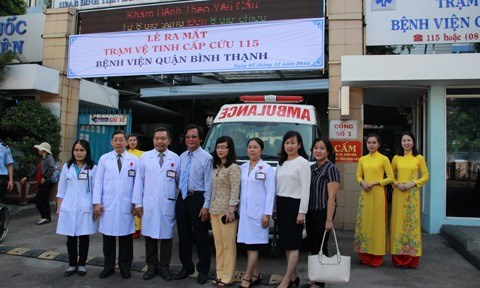
A new model that sets up satellite emergency stations in all HCM City districts has helped saved many lives, both accident victims and seriously ill patients, over the last two years.
The satellite emergency stations, functioning under district-level hospitals, have proven particularly useful in instances where there was not enough time to rush seriously injured accident victims or seriously ill patients to hospitals because of traffic congestion, a review conference heard last week.
The new model was applied after it was seen that the municipal 115 Emergency Centre, set up in 2013, was unable to fulfill its duties properly because of poor infrastructure and personnel shortages.
In response, the city’s Health Department decided to apply an out-of- hospital emergency service that had proved effective in several developed countries.
Doctor Tăng Chí Thượng, deputy director of the city’s Health Department, said they had studied the model and applied “local specific characteristics” in deploying the satellite emergency stations in districts.
These stations have been able to make full use of their human sources to rescue victims in the quickest possible way, taking advantage of the “golden time in treatment,” typically providing first aid no more than 5 minutes after receiving information, he said.
The satellite emergency stations need the co-operation and medical intervention of many health professionals from the city’s leading hospitals in order to save victims in very serious conditions.
Doctor Đỗ Thành Tuấn, head of the District 4 General Hospital, which also plays the role of a satellite emergency station, said their emergency ward received 70-80 patients from both District 4 and neighboring areas every day.
“Our doctors and medical workers have saved many people who were in critical condition before being hospitalised,” Dr Tuấn said.
“District 4’s network of narrow alleys is an obstacle course for medical workers and ambulances to reach the scene in the case of emergency. Therefore, carrying out emergency operations at a satellite hospital becomes necessary to take advantage of the golden time… .”
Dr Lê Hoàng Quý, deputy head of the Bình Thạnh District General hospital- a satellite emergency station, said they had to arrange doctors and medical workers into two first-aid shifts operating around the clock, with each shift having two doctors, four nurses and an ambulance driver.
Whenever the hospital received an emergency call, an ambulance with qualified medical workers quickly left for the scene to help victims as fast and as safely as possible.
At the same time, the hospital has set aside at least 18 beds for patients in critical situations if the number of victims is higher.
Dr Quý said surgeons were always ready to assist medical workers at emergency stations to tackle complicated cases, adding that about 30 beds were prepared for emergency cases a day.
The city’s Health Department has asked district-level hospitals to enroll as satellite emergency stations, deputy director Tăng Chí Thượng said.
As a satellite station, the hospital will be fully responsible for the preparation of adequate infrastructure, qualified ambulances and medical workers.
So far, the city has 21 satellite emergency stations, and expects all inner and outskirts districts to have at least one such station this year to respond when people call 115.
The department has recorded that the number of calls made to 115 increased to 11,854 in the first 10 months of 2016, compared to 6,805 in 2014, demonstrating increased confidence in the emergency service.
At least 30 people in critical condition have been saved.
In particular, six patients were saved by timely surgical intervention at district-level hospitals last year. Dr Tăng Chí Thượng said the risk of death would have been very high if patients had been moved to the city’s leading hospital, as was done earlier.
To develop the 115 Emergency Centre, Thượng said he had submitted to the municipal administration a project to train medical workers for out-of-hospital emergency services.
He also proposed that the city authorities invest more in infrastructure for the 115 Emergency Centre, especially in an automatic control system.
Vietnam’s population forecast to reach 100 million by 2025
While population growth has slowed, the country is grappling with a slew of problems, including gender imbalance and an aging workforce.
In 2025, the population of Vietnam will reach 100 million, an increase of 5.8% from 2016, according to a recent forecast by the Institute of Public Policy and Management.
Vietnam has managed to bring its annual population growth down to 1.07% last year. Its current population is around 92 million.
While a slow pace of population growth may take some of the pressure off the country’s resources, Vietnam’s economy is facing another problem: a rapidly aging workforce.
“To boost gross domestic product per capita, we have to aim for higher labor productivity,” said associate professor Giang Thanh Long, the director of the public policy institute.
Also according to the institute, Vietnam’s urban population will continue to expand at one of the highest rates in Southeast Asia.
Just 15 years ago, only 24.6% of its population lived in cities, with nearly 70% of the labor force in rural agriculture. Today, about 32 million people live in urban areas, accounting for approximately 34.1% of the population.
Vietnam is also faced with a huge gender imbalance, which in the longer term means between 2.3 and 4.3 million could have difficulties finding a female partner by 2050, according to population experts.
The ratio has been on a steady rise in recent years, running as high as 112 boys to 100 girls in 2015. In the countryside, the ratio can run much higher. Globally, the sex ratio at birth is estimated at 107 boys to 100 girls.
Danang installs 9 additional street surveillance cameras
Police in Danang recently announced that they will begin fining traffic violators using footage captured by nine newly-installed surveillance cameras in the city.
The local People’s Committee has approved a police proposal to crack down on traffic violations using several newly installed surveillance cameras throughout the city, Lieutenant Colonel Phan Van Thuong, deputy chief of the traffic police bureau, announced on January 5.
Police officers are running public awareness campaigns to inform locals of the new policy, Lt. Col. Thuong added, noting that the campaigns will end on January 15, just one day before the new measure comes into effect on January 16.
A police officer points at the screens at a police processing center that receives footage sent from a system of surveillance cameras installed on streets in Danang City, located in central Vietnam.
The nine surveillance cameras are located at the Ong Ich Duong-Cach Mang Thang Tam; Ho Xuan Huong-Ngu Hanh Son-Le Van Hien; Ha Huy Tap-Dien Bien Phu; 2/9 and Tran Thi Ly Bridge; Ong Ich Khiem-Le Duan; Hung Vuong-Ong Ich Khiem; Hoang Dieu-Nguyen Van Linh; and Nguyen Van Linh-Tran Phu-2/9 intersections; as well as the Nga Ba Hue Flyover.
Footage from these cameras will be sent to a police processing center where it will be used as evidence to levy fines against drivers.
The surveillance devices are also meant to help police curb traffic jams and quickly clear accident scenes.
“They will assist in our mission to fight crime as well,” said Lt. Col. Thuong.
A system of surveillance cameras has also been installed along Cach Mang Thang Tam Street, aiding police in identifying over 1,700 vehicles violating traffic regulations.
Officials slam Uber, Grab for choking up Saigon streets
15,300 cars have joined the popular ride-hailing services since their debut in 2014, aggravating Saigon’s traffic woes.
The increasing popularity of ride-hailing services in Ho Chi Minh City is thwarting the city’s efforts to limit vehicles on its already overstrained road network, officials have said.
The number of cars registered for Grab and Uber, which both arrived in the city in 2014, have topped 15,300, according to local media reports, which cited new data released by the transport department at a recent conference.
There is no further data breakdown, which means it is unclear how many of those cars are exclusively serving Grab and Uber passengers and thus it is difficult to quantify the impacts of these services on Saigon streets.
But officials said the number is high, considering that the city has been restricting the total number of taxis at roughly 11,000 over the past five years.
Nguyen Thanh Phong, the city chairman, was quoted as saying that the city has successfully controlled the taxi boom, but it is having trouble with the ride-hailing apps.
By the end of November 2016, vehicles in the city increased nearly 6% from a year ago to 7.86 million, including 615,400 cars.
There were also more than one million motorbikes brought by migrants.
Last year, the city had up to 250 new cars every day.
The growing army of vehicles has taken a toll on traffic. Public buses in December reported that the average travel speed in the city slowed down to only 18 kilometers per hour.
Ngo Hai Duong, head of the Road Infrastructure Development Management Division at the transport department, said the city has 4,155 kilometers of road, but only less than half of the city streets are wide enough for cars and buses.
VNA/VNS/VOV/SGT/SGGP/TT/TN/Dantri/VNE
The article "Social News 5/1" was originally published on http://english.vietnamnet.vn/fms/society/170733/social-news-5-1.html




